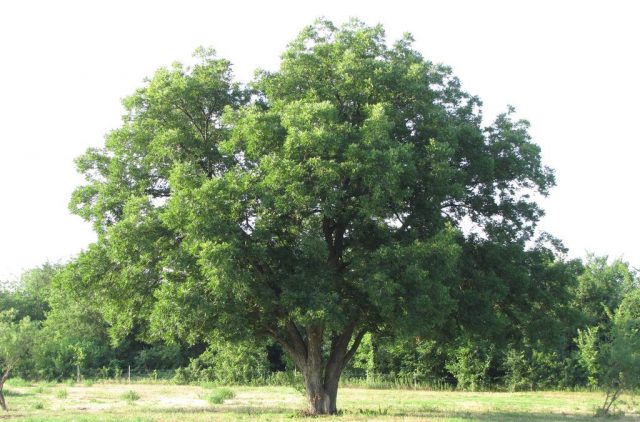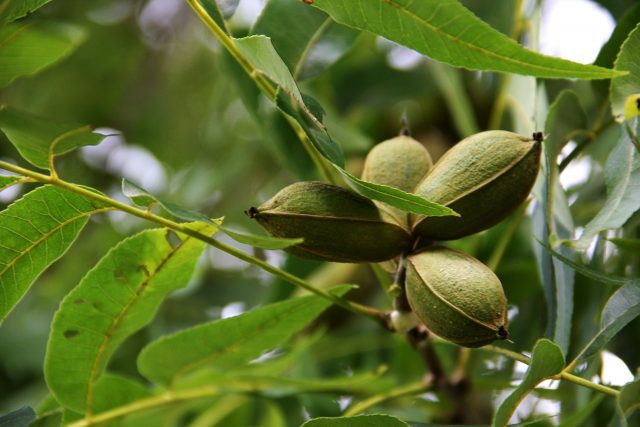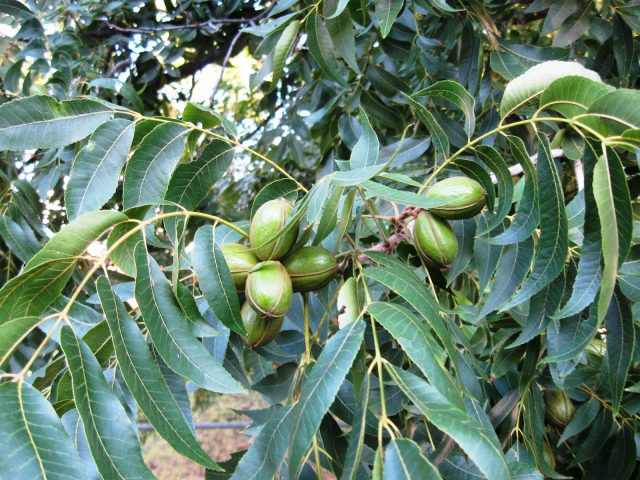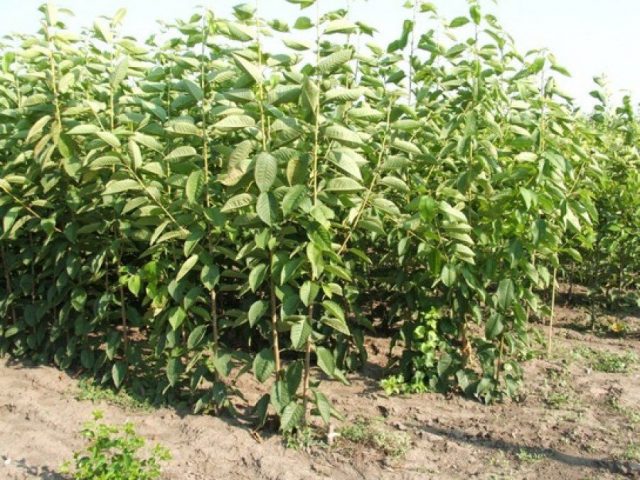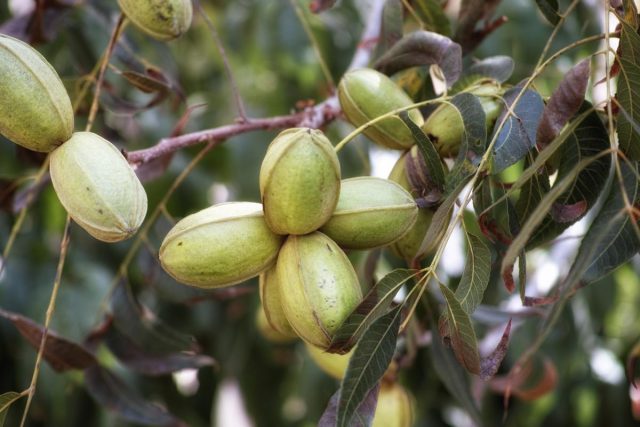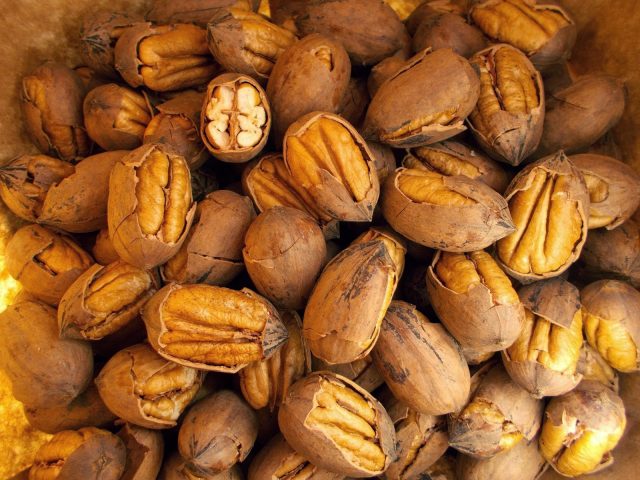Content
Common pecan remains an exotic culture for Russia. The tree is popular in North America and its fruits are nutritious. For growing pecans in the middle lane, winter-hardy varieties are chosen and provide good care for the plantings.
Where does pecan grow in Russia
The common pecan is native to the southeastern United States. On the territory of Russia, it grows in the Crimea, subject to abundant watering. The tree is also found on the Black Sea coast from Sochi to Batumi. It has no industrial value in Russia.
Gardeners cultivate common pecans in other southern regions. Walnut needs humid hot air and plenty of sun. There are known cases of successful cultivation in the middle lane and the Moscow region.
Pecan nut description
Common pecan is a member of the Nut family. A deciduous tree with a height of 25 to 60 m. In hot climates it grows up to 40 m, in the middle lane - up to 15 m. The fruiting period is up to 300 years.
The crown is spreading, wide, in the form of a tent, reaching 40 m in girth. The trunk is 2 to 3 m in diameter, straight, with brown-gray bark. There are numerous cracks on the surface of the shaft. Shoots are brown, glabrous. Leaves 5 cm long, bright green, alternate. The leaf plate is shiny, smooth, and compacted.
Photo of a pecan tree growing in its natural environment:
Flowers of male and female type. Male flowers drooping, in the form of earrings, appear at the base of the shoots. Women's - collected in 3 - 10 pieces. in spike-shaped inflorescences that grow at the ends of young branches. Flowering begins in May and ends in June.
The fruits are oblong, 7 cm long and 3 cm wide. The average weight is 20 g. They are covered with a leathery shell, which becomes hard and cracks as it ripens. Fruits grow in bunches of 3-10 pcs., Have an oval shape, a pointed apex and a length of 2 cm. Nuts are wrinkled, brown, contain a kernel. They differ from the walnut in the absence of septa and less pronounced convolutions.
Common pecans are rich in vitamins, minerals, folic acid, tannins. They also contain components that lower cholesterol levels. The nuclei are useful for vitamin deficiency, anemia, physical exhaustion, diseases of the heart and blood vessels.
Popular varieties
There are over 150 varieties of common pecans. Most of them are bred in the USA and Canada. Northern pecans are chosen for cultivation in Russia. They are highly winter-hardy and adapted to temperate climates.
The best varieties of common pecans for Russia:
- Indiana (Indiana). The oldest hybrid produced in America in 1830. Fruits weighing up to 16 g. The variety has a good taste reminiscent of chocolate. The palatability improves one month after harvest. Fruiting in mid-October. The tree tolerates frosts down to -35 ° С.
- Carlson 3 (Carlson 3). The hybrid was developed in Canada. It is one of the more northerly pecan varieties. According to the description, it gives small elongated nuts. The kernel is light brown in color and of good quality. It blooms and bears fruit early.
- Stewart (Stuart). A large variety of common pecans, it produces nuts 45 mm long and 20 mm wide.The kernel is yellow, dense, with a slight sweetish aftertaste. The fruits ripen at the end of September. Growth strength is moderate. The walnut is resistant to disease. It tolerates frosts down to -35 ° С.
- Busseron (Busseron). French hybrid, bred in 1890. Differs in productivity and ease of maintenance. Fruit weight 12 g. The taste is pleasant, chestnut. The variety has a high immunity to diseases. Frost resistance up to -35 ° С.
- Major (Major). In early October, the tree bears wide, rounded fruits. Coloring gray-brown, weight up to 12 g. The kernels are easy to extract and have a unique piquant taste. The hybrid is widespread. Resistance to frost up to -36 ° С.
- Green River (Green River). The famous American common pecan. Within 2 years after planting, the tree grows slowly, expanding rapidly. Fruits with a thin shell, light brown color. The mass of nuts is 15 g. The crop ripens in early October. The Green River variety can withstand frosts down to -36 ° С.
How to grow pecans from seeds
The material for growing pecans from seeds is harvested in late autumn. In warm climates, they are immediately planted in the garden. In the middle lane, it is recommended to germinate the seeds first. The strongest seedlings are transferred to the ground.
For autumn planting, beds with furrows are prepared. The seeds are buried 5-7 cm. When shoots appear, they are thinned out and the strongest plants are left.
Seedling method of growing ordinary pecans from seeds:
- In December, the seeds are placed in wet sand and kept in a refrigerator or cellar.
- In early March, the material is poured with warm water and left for 2 - 3 days at room temperature.
- The seeds are then poured into a container and kept warm. They are washed with water every day. It is important to keep the seeds moist and free of mold.
- When mouths appear, they are transplanted into containers with soil.
In the first year, the root forms at the nut. Such plants reach a height of 20 - 30 cm. Seedlings require constant watering. In the fall, they are planted in open ground.
Planting and caring for pecans
It is important to choose a suitable place for growing pecans. Plants are cared for throughout the season. In the fall, the walnut is prepared for wintering.
Preparation of planting material and site
Usually gardeners buy seedlings or grafted pecan seedlings. When choosing a plant, it is assessed visually. Choose a copy without mold, cracks and other damage. Work is carried out in spring or autumn, when the sap flow slows down in the trees.
To obtain a high yield, it is recommended to plant at least two types of this nut. For cross-pollination, 8 - 10 m are left between the seedlings. Grafting of different varieties on one stock is allowed.
Walnut is undemanding to the composition of the soil. The main condition is to avoid wetlands. It grows best in fertile, loose soils. Before planting, they dig up the beds, apply humus and mineral fertilizers.
Landing rules
Pecan planting order:
- First, dig a hole 50 cm deep and 60 cm in diameter.
- Fertile soil is prepared to fill it. Humus and mineral fertilizers can be added to the soil.
- The hole is filled with earth and a support is installed, then a small hill is formed.
- A seedling is placed on top, its roots are covered with soil and compacted.
- The plant is tied to a support.
Watering and feeding
The soil in the nut tree trunk circle is regularly moistened. Watering is especially important for young seedlings. At the same time, moisture stagnation is not allowed, which leads to the death of the tree.
Common pecans respond positively to feeding. In the spring, add mullein or urea solution. When forming ovaries, the nut is fertilized with potassium salt and superphosphate. The consumption of each substance for 10 liters of water is 35 g.
Trimming and shaping
Every year, weak, dry and frozen shoots are cut off from ordinary pecans. Processing is carried out in spring or autumn. For young plantings, formative pruning is performed.The processes are removed completely. The branches are not shortened, since inflorescences are formed on them.
Preparing for winter
Most varieties of common pecans are highly winter-hardy. Warming is required for young seedlings. Their trunk is wrapped with agrofibre to protect it from frost and rodents. In late autumn, the nut is watered abundantly. Then the trunk is hilled and a layer of humus mulch is poured.
Features of growing pecans in the Moscow region
To grow a northern pecan nut in the Moscow region, it is important to take into account a number of nuances:
- pick up a winter-hardy grafted variety;
- when grown from seeds, they must be stratified;
- allocate an open sunny place under a tree;
- nitrogen fertilizers are applied only in spring; they must feed the tree in summer and late autumn.
Pecans are not susceptible to spring frosts due to their early flowering. However, it is recommended to carefully prepare trees for winter, especially young plantings.
In the conditions of the Moscow region, pecans do not always have time to give a harvest over the summer. An alternative option for planting is heart-shaped hazel. It is a wild relative of the pecan nut that can withstand winter cold without any problems. Its fruits have a bitter taste.
The harvest
Common pecan ripens in September-October. Ripe fruits fall to the ground. The harvest is formed annually. When grown from seed, fruiting begins at 9 years old. In case of grafting, the tree gives a harvest for 4 years. A young plant brings up to 5 kg of nuts, an adult - about 15 kg. The maximum yield is 200 kg.
Nuts are eaten raw, dried and fried. In the shell, pecans are stored for no more than a year at a temperature of 10 - 14 ° C. Peeled kernels are kept in the refrigerator for 6 months, in room conditions - no more than 3 - 4 weeks.
Reproduction
To propagate common pecans, the following methods are used:
- Seeds... Pecans are propagated by seedlings or seeds are planted directly in open ground. The planting material is treated to increase its germination. The strongest seedlings are chosen for cultivation.
- By cuttings... Several young shoots are selected from a young tree and cut to a length of 15 cm. The cuttings are rooted in a greenhouse or at home. They are constantly looked after: watered, fed with mineral fertilizers, loosened the soil.
- Vaccination... Common pecans are planted in July or February. Two-year-old winter-hardy seedlings are used as a stock. Healthy cuttings obtained from annual shoots are grafted to the tree.
Diseases and pests
The most common diseases of common pecans are scab and spotting. These are fungal diseases that spread in cool weather with high humidity. The scab has the appearance of a brown coating that spreads throughout the tree. Signs of mottling are dark spots on leaves and shoots.
To combat diseases, special drugs are used: Bordeaux liquid, copper sulfate, Topaz, Oxyhom, Fundazol. Treatments are carried out no more than 2 times a month.
Pecans grow in a dense shell that reliably protects the kernel from pests. In North America, the tree suffers from black aphids, scale insects, pecan weevils. In Russia, the plant has no ethno-pests, therefore it is rarely attacked by insects.
Conclusion
Pecans are prized for nuts that contain a complex of nutrients. Wood prefers a humid and warm climate. Northern varieties are capable of growing in Russia. Walnut care includes watering, feeding, pruning and sheltering for the winter.
